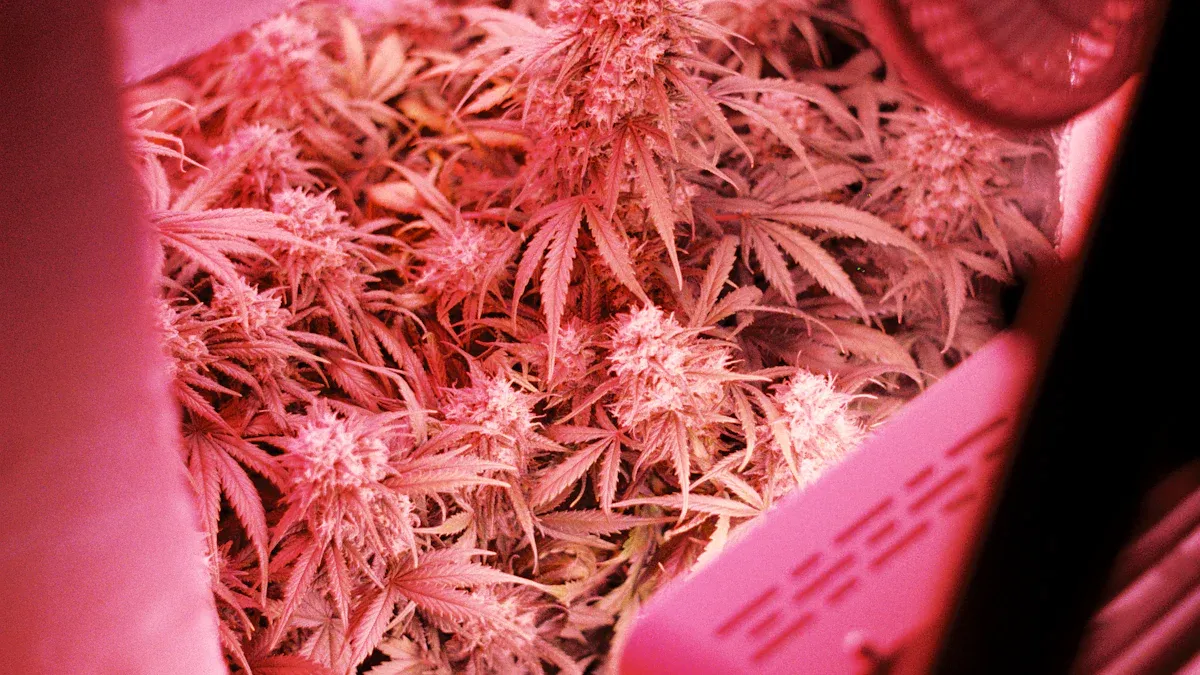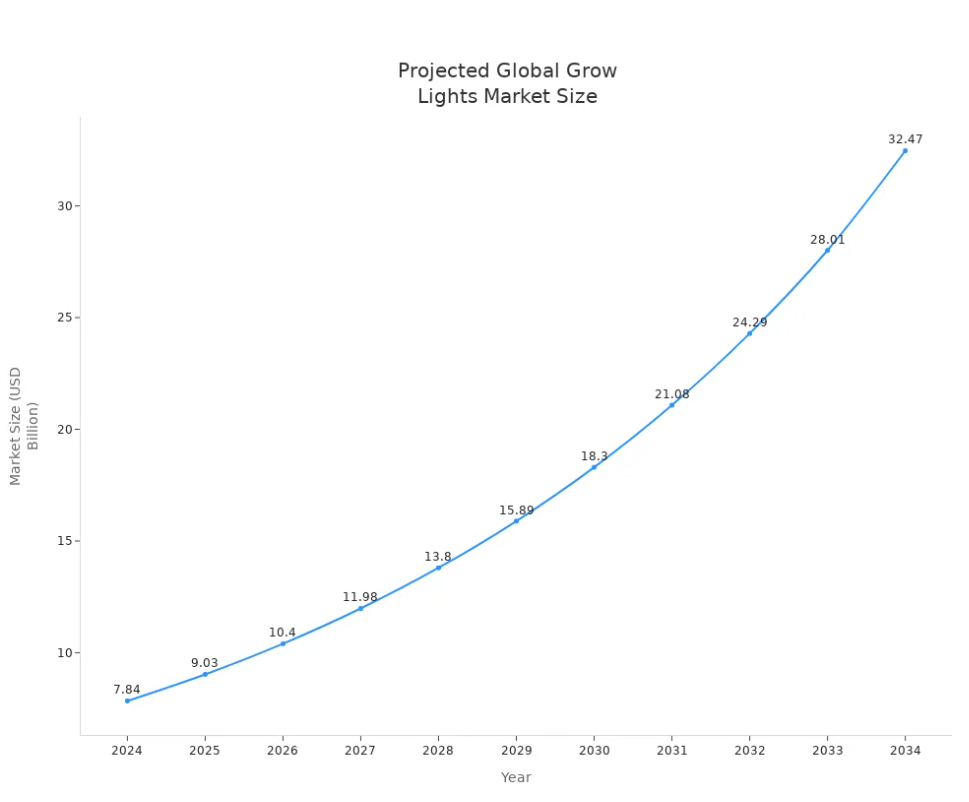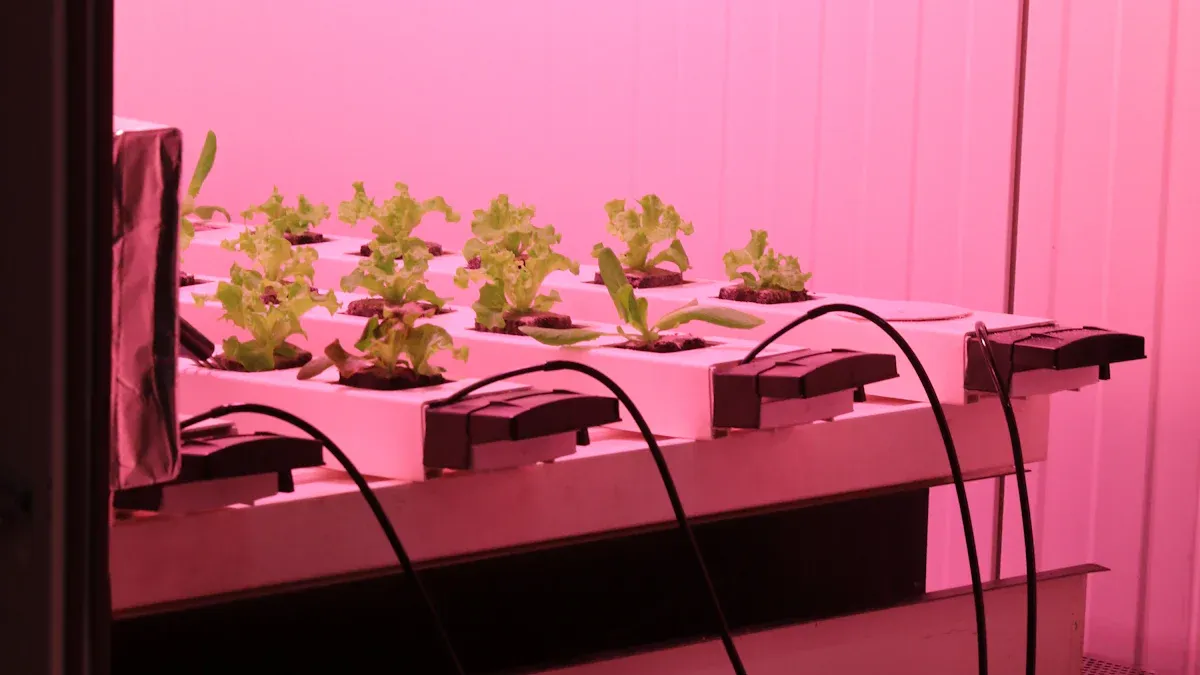
- English
- Español
- Português
- русский
- Français
- 日本語
- Deutsch
- tiếng Việt
- Italiano
- Nederlands
- ภาษาไทย
- Polski
- 한국어
- Svenska
- magyar
- Malay
- বাংলা ভাষার
- Dansk
- Suomi
- हिन्दी
- Pilipino
- Türkçe
- Gaeilge
- العربية
- Indonesia
- Norsk
- تمل
- český
- ελληνικά
- український
- Javanese
- فارسی
- தமிழ்
- తెలుగు
- नेपाली
- Burmese
- български
- ລາວ
- Latine
- Қазақша
- Euskal
- Azərbaycan
- Slovenský jazyk
- Македонски
- Lietuvos
- Eesti Keel
- Română
- Slovenski
- मराठी
- Srpski језик
Can vertical grow lights really help your plants grow better
2025-07-14
Yes, vertical grow lights can help your plants grow better. You see rapid changes in indoor gardening as more people adopt advanced grow lights for improved plant growth. Recent trends show that vertical farming in regions like North America and Asia-Pacific relies on LED technology for efficient, year-round production. New solutions such as the FANXSTAR Vfarm V30 offer energy efficiency and customizable options, making vertical grow lights essential for modern growers.
Key Takeaways
- Vertical grow lights provide even, strong light to all plant layers, helping plants grow uniformly and healthier indoors.
- LED grow lights like the FANXSTAR Vfarm V30 save energy, produce less heat, and reduce costs compared to traditional lighting.
- Customizable light spectrums let you adjust lighting for each plant stage, improving growth and increasing yields.
- Stacking plants vertically with LED lights maximizes space and allows year-round growing regardless of outdoor conditions.
- Using advanced vertical grow lights leads to faster growth, higher yields, and easier maintenance for both hobbyists and commercial growers.
How Vertical Grow Lights Work

Light Distribution
When you use vertical grow lights, you give your plants a more even spread of light across every level of your growing space. In vertical farming, careful canopy management and light penetration strategies ensure that each plant receives the right amount of energy for healthy growth. The inverse square law shows that light intensity drops quickly as you move away from the source. By placing modern LED fixtures closer to your plants, you maintain strong and uniform light coverage. This approach reduces the need to move plants around and helps you achieve consistent growth rates.
LED technology has changed the way you manage indoor gardens. The FANXSTAR Vfarm V30, for example, uses high-quality Lumileds to deliver intense and precisely tuned wavelengths. Its ultra-thin design and linkable fixtures allow you to create a seamless lighting grid. You can mount these lights on ceilings, walls, or as pendants, making it easy to adapt to any setup. The Vfarm V30’s 110°×115° beam angle ensures that every part of your plant canopy gets the same amount of light, which supports even development from top to bottom.
Tip: Adjustable hanging systems and light movers let you follow plant growth and optimize Photosynthetic Photon Flux Density (PPFD) throughout the cycle.
Canopy Penetration
You want your lower leaves to thrive, not just the top ones. Vertical grow lights, when positioned correctly, send light directly through the plant canopy. This 360-degree coverage means that even the lower leaves get direct exposure, unlike traditional horizontal systems that rely on reflected light. Properly managed vertical lighting can reach all layers, supporting uniform photosynthesis and reducing competition among plants for light.
The Vfarm V30’s advanced LED lighting system allows you to place lights closer to your plants without worrying about heat damage. Its IP65 waterproof rating and efficient heat management make it safe for various environments. By using spectrum management, you can tailor the light quality for different growth stages, ensuring that every leaf receives the optimal wavelengths for photosynthesis. This technology supports better canopy penetration and helps you achieve higher productivity and crop quality.
Benefits
Higher Yields
You want your plants to reach their full potential. Vertical grow lights, especially advanced LED systems, help you achieve higher yields by delivering consistent and targeted illumination to every layer of your crop. When you use full-coverage led lighting, you ensure that each plant receives the right amount of light, regardless of its position in the vertical stack. This approach leads to uniform plant growth and maximizes your harvest. The FANXSTAR Vfarm V30, with its high photosynthetic photon flux (PPF) efficacy of up to 2.7 μmol/J, supports robust development and increased productivity. By stacking multiple growing tiers and providing each with optimal light, you can triple your canopy space and boost your total yield compared to traditional single-layer setups.
Note: Uniform light distribution reduces competition among plants and supports even development from seedling to harvest.
Energy Efficiency
Energy costs can make or break your indoor garden. LED grow lights stand out for their remarkable efficiency and low energy consumption. When you switch from traditional high-pressure sodium (HPS) or fluorescent lights to LEDs, you can cut your energy use by 50-70%. In large-scale vertical farming, LEDs use about 600W per 4'x8' tray, while HPS systems require up to 2000W for the same area. This translates to significant energy savings and lower power bills. LEDs also emit less heat, which means you spend less on cooling and can place lights closer to your crops. The Vfarm V30’s integrated driver and IP65 waterproof design ensure reliable performance in demanding environments, further reducing maintenance and operational costs.
Here’s a quick comparison of energy use:

Tip: Lower energy use not only saves money but also supports sustainable growing practices.
Customizable Spectrum
Different plants and growth stages require specific light spectrums. Modern LED grow lights, like the Vfarm V30, let you tailor the light spectrum to match your crop’s needs. You can select full-spectrum white, blue, or red LEDs to optimize photosynthesis and plant development. For seedlings, a spectrum rich in blue light encourages strong roots and compact growth. During the vegetative stage, balanced light with extra blue wavelengths supports healthy leaves and stems. When your plants enter the flowering stage, increasing red and far-red light boosts flower size and yield.
- Seedling stage: Use blue-rich light for root strength and compact growth.
- Vegetative stage: Balanced spectrum with moderate blue light for foliage.
- Flowering stage: Increase red and far-red light to enhance blooms and yield.
The Vfarm V30 offers spectrum options for hydroponic planting and strawberry cultivation, giving you the flexibility to fine-tune your lighting. Programmable features in advanced LED systems allow you to automate light schedules and spectrum changes, ensuring your plants always receive the optimal conditions for each stage.
Customizable spectrum means you can grow a wider variety of crops and achieve better results with every harvest.
Vertical Farming Advantages

Space Optimization
You can transform your growing area by using vertical grow lights in vertical farming systems. Instead of spreading plants across a single layer, you stack multiple layers of crops in a compact footprint. This approach lets you maximize every square foot, which is especially valuable in urban and indoor agriculture settings.
- Vertical NFT hydroponics replaces traditional horizontal channels with vertical frames, allowing you to grow more plants in the same space.
- Each layer receives uniform light from strategically placed LED fixtures, so every plant gets the energy it needs.
- High-density planting increases your yield per square foot, making your indoor farms more productive.
- Efficient water and nutrient recycling reduces waste and supports sustainable practices.
Tip: Stacking crops vertically with LED lighting helps you achieve higher yields and better space utilization, even in small or unconventional locations.
Year-Round Growth
You gain full control over your growing environment with vertical farming and advanced LED lighting. LED grow lights let you adjust light intensity, duration, and spectrum for each crop and growth stage. This precision means you can grow fresh produce indoors, no matter the season or weather outside.
- LED systems produce low heat, so you can place them close to your plants and increase planting density.
- Energy-efficient LEDs lower your operational costs and support sustainable indoor agriculture.
- Smart technologies, such as sensors and automation, let you monitor and adjust lighting in real time for consistent results.
- Multi-layer lighting systems in indoor farms ensure predictable growth cycles and high-quality crops year-round.
You can rely on vertical farming to deliver consistent, high-quality produce. Controlled environments help you manage disease, reduce pests, and maintain uniform crop quality. This predictability makes indoor agriculture a reliable choice for commercial growers and hobbyists alike.
Comparison
Traditional Lighting
When you use traditional lighting systems like high-pressure sodium (HPS) or metal halide lamps, you often face high energy consumption and significant heat output. These older fixtures emit heat in all directions, which can raise the temperature in your grow space and force you to invest in extra cooling systems. This not only increases your energy bills but also makes it harder to maintain optimal conditions for your plants. Traditional grow lights require bulky reflectors to direct light, but much of the energy still gets lost as heat rather than supporting plant growth.
Switching to vertical LED grow lights changes the game. LEDs consume much less energy and produce minimal heat, so you can place them closer to your plants without causing stress or damage. This setup improves light coverage and allows you to maximize your growing area, especially in vertical farming. Studies show that you can save up to 40% on energy costs by moving from HPS to LED grow lights. You also reduce your carbon footprint and make your indoor garden more sustainable.
Tip: Lower heat output from LEDs means you spend less on cooling and can run your lights longer for better plant growth.
LED vs. Fluorescent
When you compare LED grow lights to fluorescent options, you see clear advantages in energy efficiency, plant health, and maintenance. LEDs like the FANXSTAR Vfarm V30 offer customizable light spectrums, longer lifespans, and safer operation. Fluorescent lights, such as T5 tubes, use more energy, generate more heat, and have a shorter lifespan. They also contain hazardous materials like mercury, which require special disposal.
Here’s a quick comparison:

Upgrading to the Vfarm V30 gives you a reliable, energy-saving solution that supports healthy, vigorous plant growth. You get uniform light coverage, reduced maintenance, and a safer, more efficient indoor garden.
Considerations
Plant Types
You should choose plant species that respond well to vertical grow lights for the best results. Scientific studies show that basil (Ocimum basilicum) grows significantly taller and healthier under vertical LED lighting compared to field conditions. Salvia miltiorrhiza Bunge also demonstrates improved growth and higher phenolic acid content when exposed to a mix of blue and red LED light. Cannabis sativa L. roots benefit from enhanced chemical composition and antioxidant potential under these lights. Lettuce (Lactuca sativa) varieties show increased photosynthetic rates and phenolic content, although growth rates may vary by species. These findings highlight that leafy greens, herbs, and certain medicinal plants thrive in vertical farming environments with advanced lighting.
Setup Tips
To maximize your system’s effectiveness, follow these essential setup guidelines:
- Plan your rack layout to optimize space and airflow. Place racks against walls if possible.
- Ensure the floor is level and strong enough to support loaded racks.
- Assemble racks tier-by-tier, following manufacturer instructions.
- Use correctly rated wiring and keep electrical components away from water for safety.
- Run a test after installation to set up lighting schedules, irrigation, and climate monitoring.
- Allow plants to acclimate under controlled conditions before full introduction.
- Perform regular maintenance, including checking structures, lighting, and cleaning to prevent pests.
Tip: Integrate automated irrigation, ventilation, and monitoring tools to maintain ideal growing conditions. Smart grow lights with adjustable intensity and scheduling, like the Vfarm V30, help you match light to each plant’s growth stage.
Limitations
You should consider some challenges before starting a vertical farming project. High energy consumption and continuous electricity dependence can increase operational costs. The initial investment for equipment, including grow lights and climate control, is higher than traditional systems. You may need specialized knowledge in areas like electricity, plumbing, and plant science to operate and maintain your setup. Most vertical farms focus on leafy greens, herbs, and microgreens, as cereal crops and many fruits are less suitable. Despite these challenges, high-quality LED systems such as the Vfarm V30 offer long-term savings through energy efficiency, reduced heat output, and lower maintenance needs. Their versatile, linkable design makes them a strong choice for both hobbyists and commercial growers.
Results
Research
You see clear evidence from scientific studies that vertical grow lights can transform plant growth and yield. Researchers have measured how light intensity changes from the top to the base of vertical columns. They found that lower layers often receive less light, which can limit growth. However, when you use side-on or interlighting strategies, you can boost light exposure for all layers and improve productivity.

You can also see that different LED spectra—such as blue, red, and white—affect plant growth in unique ways. For example, white LEDs with extra red and far-red light can enhance lettuce growth. Studies show that optimizing light intensity and spectrum for each plant type leads to better yields. When you use a led lighting system like the FANXSTAR Vfarm V30, you can tailor these settings for your crops. Dynamic models show that increasing light intensity above a certain point gives smaller gains, so you need to balance energy use and growth.
Note: Close-canopy lighting, where you place LEDs near the plant canopy, improves energy efficiency and yield. This approach also reduces photon loss and operational costs.
User Experiences
Growers who use advanced vertical LED grow lights report many positive outcomes. You can expect:
- Faster germination and stronger growth at every stage.
- The ability to adjust light color and intensity for each crop.
- Low heat output, so you can place lights close to plants without risk.
- Energy savings that lower your electricity bills over time.
- Simple installation and easy expansion with linkable fixtures like the Vfarm V30.
- High yields even in small spaces, thanks to customizable lighting.
- Long-lasting LEDs that reduce maintenance and replacement needs.
Many users praise the flexibility of modern systems. You can fine-tune light recipes and simulate natural sunlight, which supports healthy, vibrant plants. The FANXSTAR Vfarm V30 stands out for its customizable spectrum, waterproof design, and ease of use. Growers appreciate how it supports both hobby and commercial setups, making it a reliable choice for anyone looking to improve their indoor garden.
Tip: Advanced features such as spectrum control and integrated cooling help you maintain ideal conditions for every plant, every day.
You gain many advantages by adopting advanced LED grow lights.
- Higher photosynthetic efficacy and energy savings
- Lower heat output and reduced operational costs
- Tunable spectrum for each plant stage
- Longer lifespan and improved reliability
- Increased yields through vertical farming
Experts agree that smart LED systems with precise control boost plant growth and productivity. The market for these solutions continues to expand rapidly, as shown below:

Consider upgrading to a system like the FANXSTAR Vfarm V30. Start by researching products or testing a small-scale setup to see the benefits firsthand.
FAQ
What plants benefit most from vertical grow lights?
You see the best results with leafy greens, herbs, strawberries, and microgreens. These crops thrive under uniform, customizable LED lighting. You can also grow some medicinal plants and certain vegetables with great success in vertical farming setups.
How close should you place LED grow lights to your plants?
You should position LED grow lights like the Vfarm V30 6–12 inches above the canopy. This distance ensures strong light intensity without causing heat stress. Always monitor plant response and adjust as needed for optimal growth.
Can you use vertical grow lights for hydroponics?
Yes, you can. Vertical grow lights work well in hydroponic systems. You provide consistent, targeted light for each plant layer. This setup supports healthy root and leaf development, leading to higher yields and better crop quality.
What makes the FANXSTAR Vfarm V30 different from traditional grow lights?

You get advanced control, energy savings, and easy installation with the Vfarm V30.




